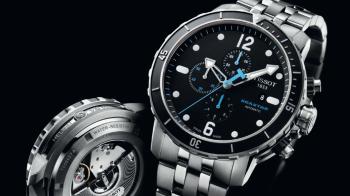The Seastar name goes back over 70 years. Originally, it was Tissot’s way of defining a water-resistant watch. The Seastar trademark itself was registered in Switzerland on 13 December 1952. Back then, the Tissot Seastar collection comprised a range of elegant, water-resistant timepieces suitable for outdoor pursuits; in 1952, recreational diving didn’t usually mean much more than a little messing around with flippers at the seaside. The Seaster proved perennially popular, and ladie's as well as men's versions gradually emerged; Tissot also brought out a line of dive watches, the legendary T2 series.
In the 1960s, the Seastar Seven marked a step change in the quest for technical progress. The watch acquired a reinforced crystal; the case became single-piece; and at the same time, the style was refined, becoming slimmer and more graceful. These aesthetic advances were later given a further boost by the widespread adoption of quartz movements; whatever one’s views about them, there’s no denying that they’ll always be thinner than their mechanical counterparts.
Between the 1980s and the turn of the millennium, Seastars seemed to wander off over the horizon somewhere, but returned to their home port in 2005 with the Seastar 660, in which the quartz movement acquired a chronograph. However, the winds of change were blowing and once again favouring mechanical authenticity. That led to the emergence of the Seastar 1000 Automatic Chronograph in 2011, and with it the best of both worlds: the historical use of a mechanical movement, as well as the accuracy offered by the later quartz models.

Maturity
The humble watertight watch of the 1950s had come of age, becoming a fully-fledged dive watch rated to a depth of 300 metres. In the version unveiled in 2011, the Seastar 1000 Automatic Chronograph was based on the ETA C01.211 calibre, a tried and tested in-house movement boasting a 45-hour power reserve, as used on innumerable Tissot chronographs (as well as a few Certinas). As to the externals, both the case and bracelet were made of steel. The latter also featured an extension system enabling it to be worn over a diving suit. A naturally more flexible rubber strap was available too. In 2011, Tissot also deemed that the time was ripe for a helium valve to be fitted to its Seastar. Even if it wasn’t really a technical necessity, the feature did drive home the point that the new Seastar 1000 was aiming to play with the big boys.
Seventy and Still Going Strong
Having returned to the limelight in 2011, the Seastar 1000 Automatic Chronograph eventually spawned ten different models, all in a case with a bold diameter of 48 millimetres. A smaller 36mm-diameter quartz version is still in the catalogue. Automatic versions are still available too, with a revised diameter of 43mm; they now benefit from the excellent performance of a Powermatic 80 calibre. Never before has a Seastar 1000 been so perfectly matched to the prevailing zeitgeist.
This year GMT Magazine and WorldTempus have embarked on the ambitious project of summarising the divers watch since 2000 in The Millennium Watch Book - Divers watch, a big, beautifully laid out coffee table book. This article is an extract. The Millennium Watch Book - Divers watch is available in both French and English here:




